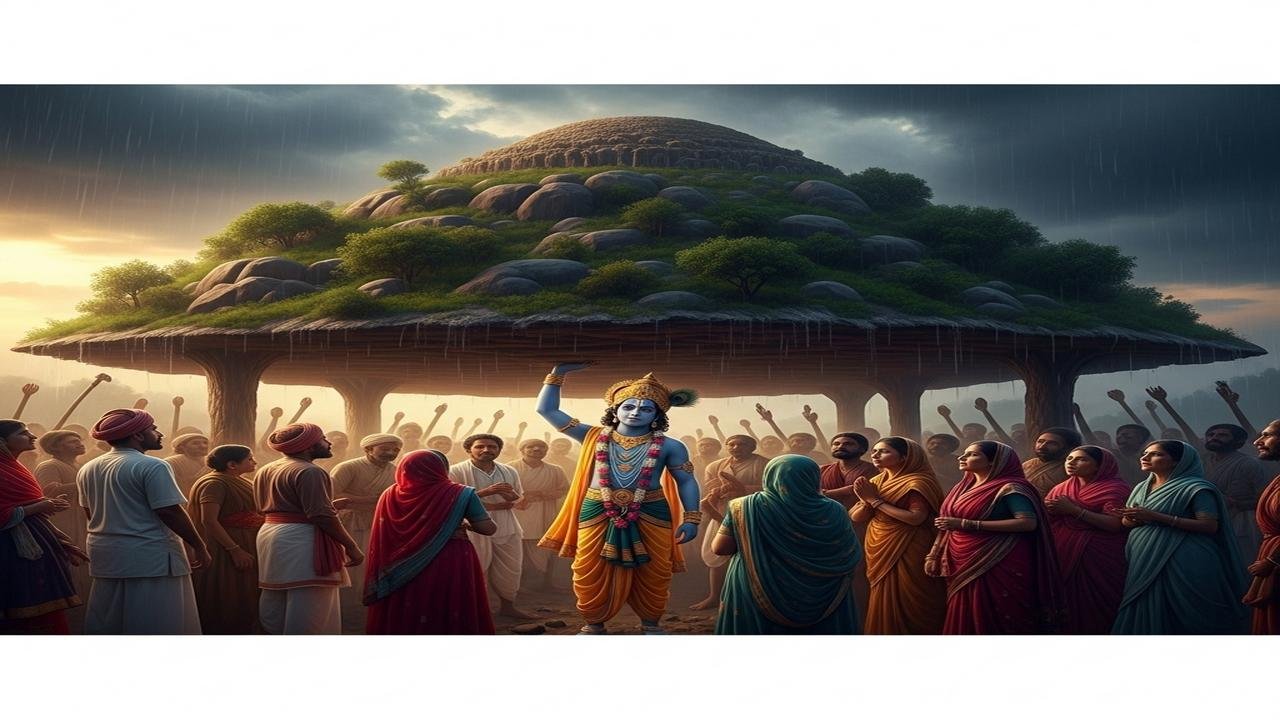Krishna Shelters Villagers Under Govardhan Hill Seven Days

The episode in scripture
The story of Krishna lifting Govardhan hill appears most famously in the Śrīmad Bhāgavata Purāṇa (Bhāgavata Purāṇa), Canto 10, chapters 25–29, and is retold in other Purāṇic works such as the Viṣṇu Purāṇa and the Harivamsa. In the narrative Krishna, a boy in the pastoral community of Vraja (around modern Mathura–Vrindavan), rescues villagers, cattle and their homes from an overwhelming storm by lifting the hill called Govardhana on his little finger and sheltering everyone beneath it for several days.
Key elements of the story
- Krishna advises the villagers to stop performing a large-scale public ritual in honour of Indra, the Vedic god of rain, and instead to care for and honour Govardhana hill and the cows — a practical focus on protection and sustenance rather than elaborate offerings.
- Offended, Indra sends torrential rains, thunder and lightning to punish the villagers.
- Krishna lifts Govardhana hill and holds it aloft as an umbrella for seven days and nights, sheltering all living beings of the village.
- Humiliated, Indra ceases his storm, offers obeisance (pranāma) and seeks forgiveness; the episode ends with reconciliation and praise of Krishna’s power.
What the story says, simply
At a surface level the incident celebrates Krishna’s protection of ordinary life — huts, cattle, pastures — against cosmic or elite power represented by Indra. It also models a leader who redirects public ritual towards locally meaningful care (fodder, cows, community) and who is capable of performing a supernatural act to defend those who follow his counsel.
Scriptural and regional sources
- Bhāgavata Purāṇa (Canto 10, chs. 25–29): the best-known, devotional account emphasising Krishna’s divine lila (play).
- Viṣṇu Purāṇa and Harivamsa: older Purāṇic retellings with variations in emphasis and detail.
- Local Braj traditions, temple histories and oral folk-songs preserve further variants and everyday ritual forms linked to the hill at Govardhana near Mathura.
How different traditions read it
- Vaiṣṇava readings: Treat the episode as proof of Krishna’s supreme divinity. The lifting is a miraculous lila that reveals God’s closeness to devotees and his role as protector.
- Smārta and ritual-critical readings: Some interpreters see Krishna’s counsel as a critique of priestly orthopraxy when ritual loses touch with social welfare; the story promotes right action — dharma — grounded in local needs.
- Philosophical and symbolic readings: Scholars and commentators sometimes read Indra as symbolic of ego, royal power or hierarchical religion, while Govardhana stands for nature, agrarian life and the household economy that sustains communities.
- Comparative and historical studies: Note parallels in Vedic and Indo‑European motifs where storm gods contest mountains or natural forces; such parallels are used cautiously to discuss older mythic patterns behind the Purāṇic story.
Ritual life and festival memory
The episode is ritually remembered in the festival often called Govardhan Puja or Annakut (the “mountain of food”), observed in many regions the day after Diwali. Devotees build clay or cow‑dung mounds to represent Govardhana, arrange hundreds of cooked dishes as an offering, and perform communal worship. In Braj, pilgrims perform parikrama (circumambulation) of the hill and visit temples dedicated to Giriraj Govardhan.
These practices combine devotion, communal feeding and a visible declaration of rural–ecological reverence. If you plan to join fasting or extended ritual observances, consider your health and consult a physician if needed.
Architecture, art and place
Govardhana hill itself (near the town of Govardhan, Mathura district) is a living pilgrimage site. Temples and shrines mark spots associated with episodes from Krishna’s youth. Paintings, folk-plays (raslila) and poetic retellings in Braj language keep the episode vivid; the image of a small child lifting a hill is a recurrent theme in classical and popular art, used to teach both wonder and moral lessons.
Interpretive tensions worth noting
- The Purāṇic story blends myth, theology and social teaching. Different readers may emphasise miracle, moral counsel, social critique, or ecological ethics; none of these exhausts the tale’s meanings.
- Some modern commentators stress the story’s affirmation of local practices and rural livelihoods; others privilege its devotional mystery — Krishna as God who protects all beings.
- Because the episode appears in multiple texts and local traditions, details (how long the storm lasts, the exact words spoken, the sequence of ritual acts) vary from source to source.
Why the story still matters
The Govardhan episode endures because it speaks to several recurrent human concerns: how community leaders balance ritual, economy and environment; how power is checked when it becomes arbitrary; and how religious imagination can sacralise local landscapes. For devotees it continues to be a story of reassurance — that the divine will shelter the humble and that devotion expressed in ordinary acts of care can be as sacred as formal offerings.
Seen from different angles — textual, ritual, artistic and ecological — Krishna lifting Govardhan remains a compact story with wide reach: a Purāṇic poem about protection, a festival about food and sharing, and a living landscape woven into devotional life across centuries.
